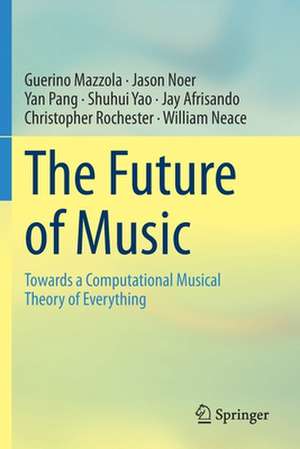The Future of Music: Towards a Computational Musical Theory of Everything
Autor Guerino Mazzola, Jason Noer, Yan Pang, Shuhui Yao, Jay Afrisando, Christopher Rochester, William Neaceen Limba Engleză Paperback – 23 mar 2021
Applying recent research results from mathematical and computational music theory and software as well as new ideas of embodiment approaches and non-Western music cultures, this book presents new composition methods and technologies. Mathematical, computational, and semiotic models of artistic presence (imaginary time, gestural creativity) as well as strategies are also covered.
This book will be of interest to composers, music technicians, and organizers in the internet-based music industry, who are offered concrete conceptual architectures and tools for their future strategies in musical creativity and production.
| Toate formatele și edițiile | Preț | Express |
|---|---|---|
| Paperback (1) | 695.01 lei 43-57 zile | |
| Springer International Publishing – 23 mar 2021 | 695.01 lei 43-57 zile | |
| Hardback (1) | 701.25 lei 43-57 zile | |
| Springer International Publishing – 23 mar 2020 | 701.25 lei 43-57 zile |
Preț: 695.01 lei
Preț vechi: 817.66 lei
-15% Nou
Puncte Express: 1043
Preț estimativ în valută:
133.03€ • 144.55$ • 111.82£
133.03€ • 144.55$ • 111.82£
Carte tipărită la comandă
Livrare economică 21 aprilie-05 mai
Preluare comenzi: 021 569.72.76
Specificații
ISBN-13: 9783030397111
ISBN-10: 3030397114
Ilustrații: XV, 242 p. 120 illus., 101 illus. in color.
Dimensiuni: 155 x 235 mm
Greutate: 0.37 kg
Ediția:1st ed. 2020
Editura: Springer International Publishing
Colecția Springer
Locul publicării:Cham, Switzerland
ISBN-10: 3030397114
Ilustrații: XV, 242 p. 120 illus., 101 illus. in color.
Dimensiuni: 155 x 235 mm
Greutate: 0.37 kg
Ediția:1st ed. 2020
Editura: Springer International Publishing
Colecția Springer
Locul publicării:Cham, Switzerland
Cuprins
Part I Introduction.- 1 General Introduction.- 2 Ontology and Oniontology.- 3 The Basic Functions of Music.- 4 Historicity in Music.- 5 Only One Restriction: Quality.- Part II Technological Tools.- 6 Software Tools and Hardware Options.- 7 New Concepts of Musical Instruments.- 8 Musical Distribution Channels: New Networks.- 9 Big Science in Music.- Part III Mathematical Concepts.- 10 Mathematical Music Theory.- 11 Serialism: Failure of New Concepts without Musical Impact.- 12 Mazzola’s Sonata Construction: A Technical Approach and its Limits.- 13 Imaginary Time.- 14 Mathematical Gesture Theory.- 15 Future Theories (Counterpoint etc.).- Part IV Cultural Extensions.- 16 A Critique of the Western Concept of Music.- 17 Improvisation and the Synthesis Project on the Presto Software.- 18 Art Making as Research.- 19 Human and Machine Music.- 20 Music in the Diversifying Cultures.- 21 Cultural Theories of Gesture.- Part V Creative Strategies.- 22 Recapitulation of Creativity Theory.- 23 The Specifically Musical Walls Against Creativity.- 24 Examples of Creative Extensions in Music.- 25 Performance and Composition.- 26 Are Aesthetics and Business Antagonists?.- Part VI COMMUTE.- 27 ComMute—Towards a Computational Musical Theory of Everything.
Recenzii
“This is a thought-provoking book of impressive breadth and vision which I recommend to everyone who’s interested in mathematical and computational approaches to music.” (Santi Spadaro, zbMATH 1479.00010, 2022)
“I found professional, academic musicians’ thoughts about future music, computers, software, artificial intelligence (AI), and creativity. I did thoroughly enjoy reading about the changes that have come in the field of music and what they hope for the future. The important audience for this book includes any computer scientist who intends to work with musicians on musical software; learning the terminology and views would be useful for understanding the problems to be solved.” (David A. Gustafson, Computing Reviews, November 23, 2020)
“I found professional, academic musicians’ thoughts about future music, computers, software, artificial intelligence (AI), and creativity. I did thoroughly enjoy reading about the changes that have come in the field of music and what they hope for the future. The important audience for this book includes any computer scientist who intends to work with musicians on musical software; learning the terminology and views would be useful for understanding the problems to be solved.” (David A. Gustafson, Computing Reviews, November 23, 2020)
Textul de pe ultima copertă
The idea of this monograph is to present an overview of decisive theoretical, computational, technological, aesthetical, artistic, economical, and sociological directions to create future music. It features a unique insight into dominant scientific and artistic new directions, which are guaranteed by the authors' prominent publications in books, software, musical, and dance productions.
Applying recent research results from mathematical and computational music theory and software as well as new ideas of embodiment approaches and non-Western music cultures, this book presents new composition methods and technologies. Mathematical, computational, and semiotic models of artistic presence (imaginary time, gestural creativity) as well as strategies are also covered.
This book will be of interest to composers, music technicians, and organizers in the internet-based music industry, who are offered concrete conceptual architectures and tools for their future strategies in musical creativity and production.
Applying recent research results from mathematical and computational music theory and software as well as new ideas of embodiment approaches and non-Western music cultures, this book presents new composition methods and technologies. Mathematical, computational, and semiotic models of artistic presence (imaginary time, gestural creativity) as well as strategies are also covered.
This book will be of interest to composers, music technicians, and organizers in the internet-based music industry, who are offered concrete conceptual architectures and tools for their future strategies in musical creativity and production.
Caracteristici
Presents newest mathematical music theory and embodiment science in a concise way with concrete examples and illustrations Passes on knowledge of involved professionals as the authors are all active as creators of music and dance Thematizes the well-known physics principle of a theory of everything in music
